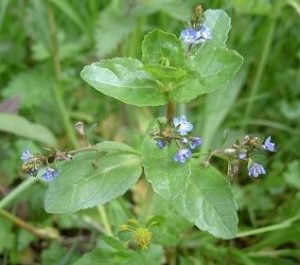Brooklime
Home " Bank plants " Brooklime
Brooklime. For Effective Nitrite Removal from your Pond.
Nitrite is a toxic substance that can build up in the water when fish are present in the pond. It can eventually kill the fish and other animals. There are several products that remove nitrite from pond water. Brooklime can be supportive in this. Indeed, it is good at removing nitrite.
Its Latin name is Veronica Beccabunga. This plant is related to plantain and is edible (delicious in salad!) It is a riparian plant that grows and flowers on the sides of ditches and streams throughout the Netherlands and Belgium. This marsh plant grows both under and above water. It can then cover a considerable area of water which is a beautiful sight.
This riparian plant grows by means of the many small roots attached to the thick green stem. As soon as these touch the ground, they form rhizomes. These rhizomes emerge under water with a bend. Above water, egg-shaped, jagged leaves and blue flowers form.
Brooklime Properties
- Veronica beccabunga
- Grows between 15 and 60 cm tall
- Sun or partial shade
- Blooms in the months from May to September
- Egg-shaped and serrated leaf
- Blue flowers
Frequently asked questions
What are the benefits of Brooklime in your pond?
Brooklime has an important function in the pond. This marsh plant is fine for use in the pond. It should be planted in baskets or, of course, in the wet banks. It is a good ground cover that grows quickly. The small blue flowers between the green leaves are a nice sight. It flowers from May to September. The leaves survive the winter because the plant produces a kind of "anti-freeze" substance.
Its biggest asset, of course, is the absorption of nitrite from the water! This keeps your pond healthy.
What is the growth height of brook spurge?
This marsh plant grows horizontally across the water surface, growing to between 15 and 60 cm in length.
What is the flowering time of brook spurge?
The flowering season of brook spike (Veronica beccabunga) is from May to September. During these months, the plant produces small, blue to light purple flowers grouped in clusters. Although the flowers are small, they provide subtle colour in wet gardens, along water sides or in ponds. The prolonged flowering makes the plant an attractive choice for gardeners keen to add colour to wet areas.
Is brook spike native?
Yes, Brooklime is native to the Netherlands and other parts of Europe. This plant occurs naturally along banks of streams, ditches, ponds and other wetlands. Beekpunge is well adapted to wet conditions and plays a role in supporting local ecosystems, where it provides a habitat and food source for insects such as bees and other pollinators. It also occurs in other parts of the world, but its origins are in Europe.
How fast does brook spurge grow?
Brook spurge grows relatively quickly, especially in moist conditions. The plant forms creeping rhizomes quickly and can spread easily over wet soil or in shallow water. This rapid growth makes brook spurge suitable for quickly filling wet, open spaces in the garden or along banks. Because it spreads so quickly, brook spike can cover large areas if not regularly maintained.
How do I maintain brook punge?
Brooklime requires little maintenance and is a robust plant that thrives in moist to wet soil or shallow water. The most important aspect of maintenance is making sure that the plant always has sufficient moisture, as it naturally occurs in wet environments. Brookpunge grows well in both full sun and semi-shade. To keep the plant under control, prune it from time to time and remove any seedlings, as it can spread quickly. Remove dead leaves and stems in autumn or early spring to keep the plant looking tidy.
How should I prune brookpunge?
Brooklime pruning is easy and helps control its rapid growth. The best time to prune is in early spring or after flowering in summer. You can prune the plant back to just above the ground or waterline to remove excess growth and old stems. By pruning in between, you prevent the plant from taking up too much space and growing over other plants. If the plant gets too big, you can also remove parts of the rhizomes to limit growth.
What is the planting depth of brook spurge?
Brooklime can be planted in moist soil as well as in shallow water. The ideal planting depth is about 0 to 10 cm of water above the roots. It grows well along the banks of ponds, streams and other water features, where its roots remain constantly moist. Make sure the roots are in wet, soggy soil, as drought can greatly hinder the plant's growth. Brookpunge is a versatile aquatic plant suitable for shallow waters and moist soil.
Buy Brooklime?

Brooklime is for sale via De Vijvermeester's webshop. Here you can find beautiful, high-quality marsh plants.
